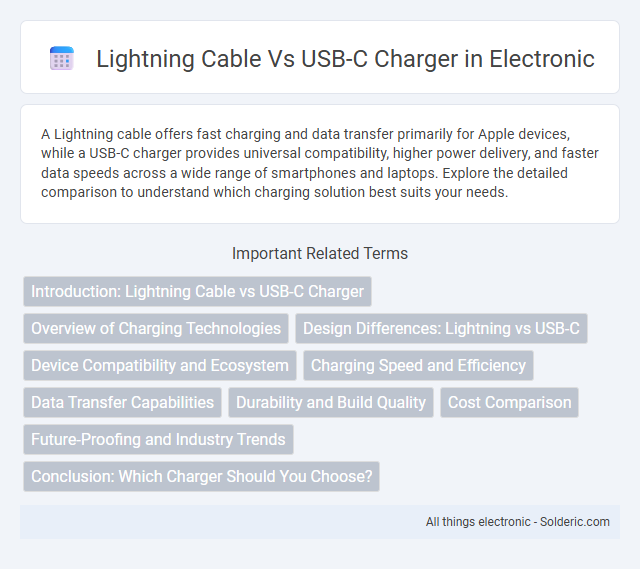A Lightning cable offers fast charging and data transfer primarily for Apple devices, while a USB-C charger provides universal compatibility, higher power delivery, and faster data speeds across a wide range of smartphones and laptops. Explore the detailed comparison to understand which charging solution best suits your needs.
Comparison Table
| Feature | Lightning Cable | USB-C Charger |
|---|---|---|
| Connector Type | 8-pin proprietary Apple connector | Universal USB Type-C connector |
| Compatibility | Apple devices: iPhone, iPad (older models), iPod | Wide range: smartphones, tablets, laptops, and accessories |
| Data Transfer Speed | Up to USB 2.0 speed (480 Mbps) | Up to USB 3.2 Gen 2 or Thunderbolt 3/4 speeds (10-40 Gbps) |
| Charging Power | Max 12W (5V/2.4A) for standard charging | Supports fast charging up to 100W (20V/5A) |
| Reversibility | Reversible connector | Reversible connector |
| Durability | Moderate; prone to wear on connector end | High; robust design, better wear resistance |
| Usage Trend | Being phased out in favor of USB-C on Apple devices | Becoming industry standard for new devices |
Introduction: Lightning Cable vs USB-C Charger
Lightning cables offer fast charging and data transfer primarily for Apple devices, featuring a proprietary 8-pin design compatible with iPhones, iPads, and select accessories. USB-C chargers provide universal compatibility, delivering higher power output and faster data speeds across multiple brands and devices, including laptops, tablets, and smartphones. Choosing your charger impacts device compatibility, charging speed, and overall convenience, especially as USB-C becomes the industry standard.
Overview of Charging Technologies
Lightning cables utilize a proprietary 8-pin connector designed primarily for Apple devices, delivering efficient power transfer with support for fast charging when paired with compatible adapters. USB-C chargers offer a universal standard with reversible connectors, higher power delivery capabilities up to 100W, and faster data transfer speeds, making them suitable for a wide range of devices beyond Apple's ecosystem. The transition from Lightning to USB-C reflects a shift towards more versatile and standardized charging technology that enhances user convenience and device interoperability.
Design Differences: Lightning vs USB-C
Lightning cables feature an 8-pin connector designed exclusively by Apple, offering a slim, reversible design for seamless connection to Apple devices. USB-C chargers utilize a standardized 24-pin connector that supports faster data transfer and higher power delivery, making them compatible with a wide range of devices beyond Apple products. The symmetrical, reversible USB-C design emphasizes durability and universality, contrasting with the proprietary nature of the Lightning cable.
Device Compatibility and Ecosystem
Lightning cables are primarily compatible with Apple devices such as iPhones, iPads, and certain iPods, fitting seamlessly into the Apple ecosystem for reliable charging and data transfer. USB-C chargers offer broader compatibility, supporting a wide range of devices including newer Android smartphones, laptops, tablets, and some Apple products like the latest iPad Pro and MacBook models. Your choice between Lightning and USB-C should consider the devices you use most frequently to ensure optimal compatibility and convenience within your digital ecosystem.
Charging Speed and Efficiency
USB-C chargers generally offer faster charging speeds and greater efficiency compared to Lightning cables, thanks to higher power delivery capabilities and support for USB Power Delivery (PD) standards. Your devices equipped with USB-C ports can benefit from rapid charging, often reaching 50% battery in around 30 minutes, while Lightning cables typically have lower wattage limits and slower power transfer. Optimizing your charging setup with USB-C technology ensures quicker, more energy-efficient power delivery, reducing downtime and enhancing overall device performance.
Data Transfer Capabilities
Lightning cables support data transfer speeds up to USB 2.0 standards, approximately 480 Mbps, limiting their efficiency for large file transfers. USB-C chargers leverage USB 3.1 or USB 3.2 protocols, enabling data transfer rates up to 10 Gbps or higher, significantly enhancing speed and performance. This makes USB-C the preferred choice for faster syncing and high-bandwidth applications such as video output and external device connectivity.
Durability and Build Quality
Lightning cables often feature a sturdy construction with reinforced connectors and thick insulation, designed to withstand frequent bending and daily wear. USB-C chargers boast a universal design with robust, reversible connectors that reduce strain and promote longer lifespan, often utilizing premium materials like braided nylon for enhanced durability. Your choice should consider device compatibility alongside the superior build quality that ensures sustained performance over time.
Cost Comparison
Lightning cables generally cost more than USB-C chargers due to Apple's proprietary technology and licensing fees, with prices typically ranging from $19 to $29 compared to USB-C's $10 to $20 for standard models. USB-C cables offer greater affordability and compatibility across multiple devices, reducing the need for multiple chargers and lowering your overall charging expenses. Choosing USB-C can optimize your budget by providing a versatile, cost-effective solution without compromising performance.
Future-Proofing and Industry Trends
USB-C chargers are rapidly becoming the industry standard due to their faster charging speeds, improved data transfer rates, and universal compatibility across devices, ensuring better future-proofing for Your electronics. Lightning cables, primarily used by Apple devices, face decreasing manufacturer support as the tech world shifts toward USB-C, driven by regulatory mandates like the EU's common charger directive. Investing in USB-C today aligns with industry trends, providing greater convenience and longevity as more devices adopt this versatile standard.
Conclusion: Which Charger Should You Choose?
Choosing between a Lightning cable and a USB-C charger depends on device compatibility and charging speed priorities. USB-C offers faster data transfer rates up to 10 Gbps and higher power delivery, ideal for newer iPhones and MacBooks, while Lightning cables remain essential for older Apple devices. For future-proofing and universal use, USB-C is the recommended choice due to its widespread adoption across multiple platforms.
Lightning cable vs USB-C charger Infographic

 solderic.com
solderic.com